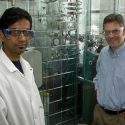A single gene controls a key difference between maize and its wild ancestor
One of the greatest agricultural and evolutionary puzzles is the origin of maize – and part of the answer may lie in a plot of corn on the western edge of Madison, where a hybrid crop gives new life to ancient genetic material.
While many biologists argue that teosinte, a wild Mexican grass, is the progenitor of maize, others believe that the differences between teosinte and maize are too complex to have arisen through natural mutation or human selection. One of the most significant inconsistencies between the two plants is that teosinte kernels are locked in a hardened casing and have to be cracked like walnuts, while maize kernels are exposed on the surface of the ear.
However, a team led by a UW–Madison geneticist has demonstrated that a single gene, called tga1, controls kernel casing. And beyond implications for the study of maize evolution, the results are evidence that modest alterations in single genes can cause dramatic changes in the way traits are expressed, the team wrote in the August issue of the journal Nature.
“What really interests me is how traits evolve,” says John Doebley, the professor of genetics who led the study. “How did changes in genes cause the diversity of life to arise on earth? The corn and teosinte model is an excellent system to investigate this question.”
While Doebley has laboratory facilities on campus, he is equally at home in the field plots at the West Madison Agricultural Research Station where he raises second-generation hybrids of teosinte and maize. He studies the inheritance of different traits in the hybrids and uses genetic tools to identify the genes involved, applying highly advanced technology to an ancient species.
The history of corn is closely intertwined with the history of humans in the New World, says Doebley. “In the Americas, corn – which was first domesticated in southern Mexico – fueled the societies and the cultures that developed. Without corn, the societies of the new world would have been completely different.”
However, the genetic changes that occurred during the domestication of corn have been a controversial issue in the field of evolutionary biology, Doebley says. “Some argue that evolution works like building up a sandstone cliff with lots of tiny grains deposited over a very long time. Others believe that there may be big boulders set into that cliff – or that evolutionary changes may result from single genes with very big effects.”
In fact, Doebley says that his team’s findings “fit exactly with the idea that a single gene change, or a small number of changes, could be sufficient to make teosinte a useful food crop, and in a relatively short amount of time.” He adds that it is likely that a change in just one amino acid within the gene was enough to cause the key event, and ultimately influence human society in the new world.
The process of maize evolution might have begun with humans growing teosinte as a food source – although an inefficient one, says Doebley. “And then in the fields popped up a new mutation that changed the tga1 gene and reduced the kernel casings,” he says. “Humans then would have applied artificial selection, and soon almost every plant they grew would have had the exposed kernels.”
Although the results published in Nature shed light on one great mystery, there is much still to learn. Doebley and colleagues at six institutions are almost halfway through a five-year project to study the molecular and functional diversity of the maize genome. At $10 million, the National Science Foundation grant that supports the project is one of the largest awards ever given for plant research. Doebley is trying to identify which genes ancient farmers selected for their crops. In a recent paper published in the journal Science, the team presented analysis indicating that 2 to 4 percent of the genes in the maize genome experienced artificial selection.
Doebley’s team for the Nature paper included Huai Wang, a current postdoctoral student; Qiong Zhao, a current graduate student; Yves Vigouroux, a former postdoctoral student; Kirsten Bomblies and Lewis Lukens, former graduate students; Tina Nussbaum-Wagler, a research specialist; and Bailin Li and Mariana Faller, researchers at the DuPont corporation.
The work is funded by the National Institutes of Health, NSF, the United States Department of Agriculture and the state of Wisconsin.
Tags: biosciences, research



